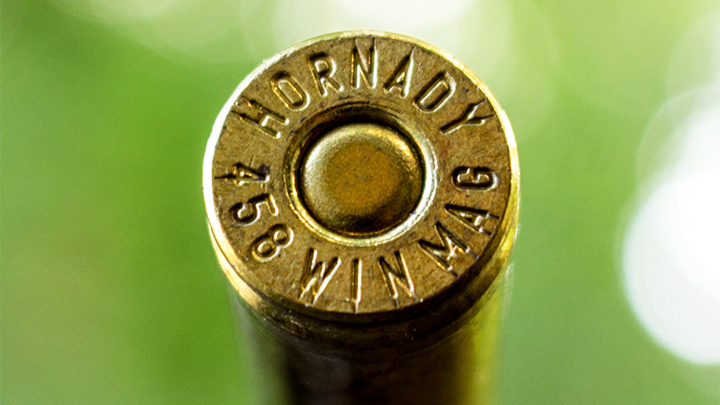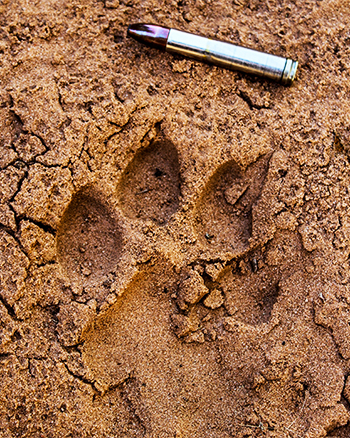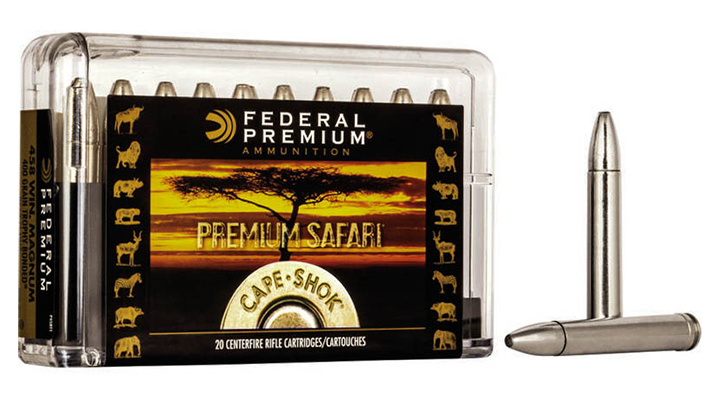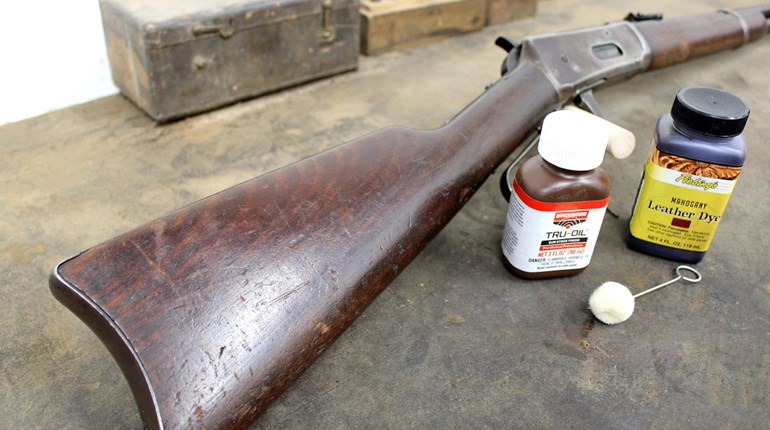
In the wake of the Second World War, when things had calmed down enough to allow hunters and outfitters to once again turn their attentions toward their passion for big game instead of turning against one another, there was a definite turning of the ballistic tide. In East Africa, the center of the safari industry, rifles and ammunition were ‘catch-as-catch-can’ in times of plenty, and in the post-WWII era, the ammunition supplies for the classic British double rifles began to dwindle, as the manufacturers were simply crippled by the war effort, and Britain’s economy and supplies were lacking.

Winchester—wisely—went to work in the 1950s on a trio of “short” magnum cartridges which were designed to check all the boxes on game animals from big to small. The .264 Winchester Magnum—a 6.5mm cartridge that still performs well—was a wonderful choice for deer, antelope and other species, the .338 Winchester Magnum would go on to become the darling of many elk hunters and would be relied upon by a formidable number of Alaskan guides and hunters alike. But the largest of the group, the .458 Winchester Magnum, would fill a huge void in the safari industry, but had its own set of challenges early on.
The four-five-eight was designed to replicate the ballistics of the benchmark dangerous-game cartridge: John Rigby & Co.’s.450 3¼-inch Nitro Express. Driving a 480-grain bullet of .458-inch-diameter to a muzzle velocity of 2150 fps, the .450 NE became the industry standard, and upon the ban of .458-inch-caliber ammunition in the British territories, a multitude of rimmed cartridges were developed to mimic the formula, including the .470 Nitro Express.

Winchester chose the belted .375 H&H case as the platform for their trio of mew cartridges, shortening the case length to 2½ inches to work nicely on a standard long-action (read .30-06 length) and the .458 Winchester was the first of the three to be released. It is a straight-walled cartridge with minimal taper and headspaces of the belt. It was advertised to deliver a 510-grain bullet at 2150 fps from a 26-inch test barrel. Few .458 Winchester rifles wore a barrel that long, and almost none attained that velocity—at least in the first few decades of existence.
Less-than-favorable reports came in from the fields; anything from poor penetration to clumped powder charges that didn’t ignite properly to (questionable, I’ll admit) reports of bullets actually bouncing off of an elephant’s shoulder. Some felt the limited powder capacity and resulting lower-than-desired velocities were a deal-breaker; guys like Jack Lott lengthened the case to increase both capacity and velocity.

At any rate, there were issues with powder capacity of the .458 Winchester, and with velocities struggling to break the 2000 fps mark, what it did represent was the only true big-bore choice available in an American-made rifle and ammunition line, and many professional hunters and their clients alike came to rely on the .458, as it and the .375 H&H Magnum were just about the only options. From a handloader’s perspective, I can attest to the fact that the case capacity can be a struggle, but I’ve reached the 2150 fps mark with 500-grain bullets. And in spite of all of those reports early-on, I can happily say that the problems with the .458 Winchester Magnum have been sorted out.
Modern ammunition delivers the original conceived velocity, pushing a 500-grain bullet in the realm of 2150 fps, depending on brand, attaining the 5,000 ft.-lbs. of muzzle energy Winchester was after all along. I also feel that the lineup of modern super-softpoints and technically brilliant solids have enhanced the performance of the .458 Win. Mag.; those engineers from the 1950s would be tickled pink to see what a Barnes TSX, Federal Trophy Bonded Bear Claw or Woodleigh Hydrostatically Stabilized Soliddoes on dangerous game.
The recoil of the .458 Winchester is not for the faint of heart, as it will take some conditioning to become accustomed to the massive push of the rifle. My advice for those who wish to hunt with the cartridge is to zero your rifle from the bench, and then get off that bench altogether. You’ll find the cartridge is much more pleasant to shoot from field positions—offhand, off shooting sticks, kneeling, etc.—than from a bench. I’d also emphasize the importance of stock fit; I did the load development for a Winchester 70 with a 22-inch barrel which my Dad brought to Tanzania, and it was just too short for me. After a session at the bench with that gun, it felt like I’d gone three rounds with a boxer much better than me.
Looking at some generalized figures, as rifle weight and stock fit will vary, the .458 Winchester Magnum with its standard load will generate 62 ft.-lbs. of recoil energy at a recoil speed of 21 fps. Compare that to the .416 Rigby’s 58 ft.-lbs. at 20 fps and the .375 H&H’s 37 ft.-lbs. at 16 fps, and you can see why the .458 can be at or near the top of some shooter’s recoil limits.
My favorite factory loads for the .458 include Hornady’s pair of 500-grain DGX Bonded softpoint (a big improvement over the older design) and DGS Solid, Federal’s Cape Shok 500-grain Woodleigh Hydrostatically Stabilized Solid (perhaps my single favorite dangerous game bullet) and Federal’s 400-grain Trophy Bonded Bear Claw load.
Though that Bear Claw is lighter than normal, it is structurally sound and makes a wonderful choice for those who want to use their .458 Winchester in Alaska for the great bears, or for moose, bison and other large species. With a 100-yard zero, the 400-grain Bear Claw at 2250 fps is 7 inches low at 200 yards, compared to the 500-grain Bear Claw printing 9.2 inches low at that mark. I feel this load extends the versatility of the cartridge; it’s more than just a stopping rifle.

The .458 Winchester, loaded with a proper bullet, will handle any game on earth. With softpoints, it’s great for Cape buffalo, brown bear, and lion; with solids, it handles elephant and hippo very well. Is it a good choice for plains game, elk and similar-sized game? Inside of 150 yards it’ll certainly work, but I think there are better choices for a kudu at 300 yards or a bull elk at 350.
Perhaps I have been a bit too hard on the .458 Winchester in the past—with a prejudice derived from that nasty short-barreled Winchester that beat me up so bad at the bench—as there are plenty of sound choices in both the rifle and ammunition department. As a reloader, I do find the .458 Lott easier to work with, even if maintaining Win. Mag. velocities, but for a big game hunter who finds a good deal on a .458 Winchester, there’s really no reason to turn that deal down.
Looking for previous installments of our "Behind the Bullet" series? We've got you covered.
• .22 Hornet
• .280 Ackley Improved
• .240 Weatherby Magnum
• .458 Lott
• .264 Winchester Magnum
• .348 Winchester
• .33 Nosler
• .260 Remington
• .30-30 Winchester
• .416 Rigby
• .358 Norma Magnum
• .22 LR
• 7mm-08 Remington
• 8mm Remington Magnum
• .338 Federal
• .224 Valkyrie
• .338-06 A-Square
• 9.3x62mm Mauser
• .257 Weatherby Magnum
• .45-70 Government
• .300 H&H Magnum
• .25-06 Remington
• .30-06 Springfield
• 6.5 Creedmoor
• .300 Remington Ultra Magnum
• 7mm Remington Magnum
• .470 Nitro Express
• .280 Remington
• .300 Winchester Magnum
• .270 Winchester
• .222 Remington
• .45 ACP
• .404 Jeffery
• .44 Remington Magnum
• .41 Remington Magnum
• .243 Winchester
• .338 Winchester Magnum
• .357 S&W Magnum
• 6.5-284 Norma
• 8x57 Mauser
• .38 Smith & Wesson Special
• 7x57mm Mauser
• 9 mm Luger
• .35 Whelen
• .454 Casull
• .375 H&H Magnum
• .45 Colt
• .22-250 Remington
• 10mm Auto
• .308 Winchester




































